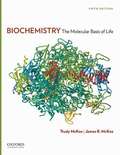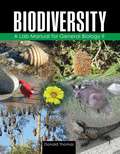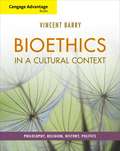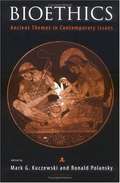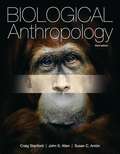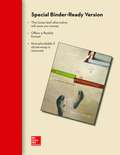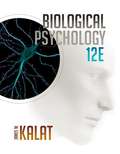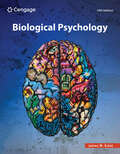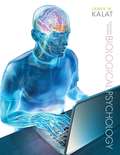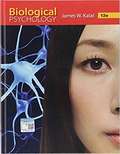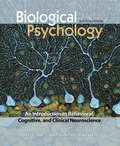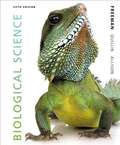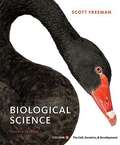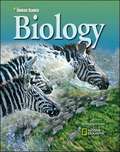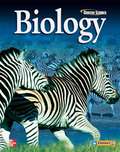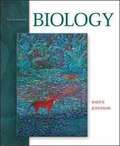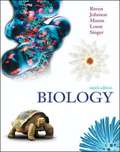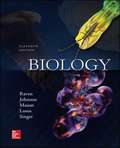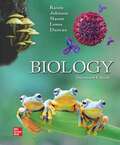- Table View
- List View
Biochemistry: The Molecular Basis of Life
by James R. Mckee Trudy MckeeBiochemistry: The Molecular Basis of Life is an intermediate, one-semester text written for students on degree pathways in Chemistry, Biology and other Health and Life Sciences. Aimed at students with one unit of Organic Chemistry, it focuses on essential biochemical principles that underpin the modern life sciences, and offers a balanced coverage of chemistry and biology.
Biodiversity: A Lab Manual For General Biology II
by Donald R. ThomasThis lab manual is intended to accompany the General Biology II course at Southwest Tennessee Community College. This course focuses on the evolution and diversity of living organisms with attention to comparative anatomy within the vertebrate animals. The manual contains instructions for hands-on examination of specimens with minimal repetition of content found in the recommended textbook (Biology. Solomon and Berg, current edition). This format is used with the motive of saving costs for the student and encouraging the use of the text and the instructor s assistance for explaining unfamiliar vocabulary. In addition to the illustrations in this manual, students may also find photographs and anatomical diagrams of the subjects on the internet as well as in the textbook"
Bioethics In A Cultural Context: Philosophy, Religion, History, Politics
by Vincent BarryBIOETHICS IN A CULTURAL CONTEXT--PHILOSOPHY, RELIGION, HISTORY, POLITICS presents a unique, philosophical approach to modern bioethics. Rather than simply setting up debates about contemporary issues, this book helps students understand that many of today's bioethical controversies are tied to profound underlying questions fundamental as: When does life begin and end? What is a human being or person? What is life's purpose? What is the ideal society? The text is comprehensive and accessible, featuring a wide range of content that is crisply presented and clearly explained. A multitude of interesting examples and cases provides ample opportunity for discussion, debate, and research.
Bioethics: Ancient Themes in Contemporary Issues
by Mark G. Kuczewski Ronald M. PolanskyThis collection of essays explores themes from ancient Greek philosophy and medicine and their implications for contemporary medicine and bio-medical ethics. Thus the work examines the relationship of two of the most popular areas in the current revival of ethics, namely, classical ethics and biomedical ethics--areas that have seldom been brought together in any serious or sustained way. The essays in this volume are written by established classical scholars and bioethicists.
Biological Anthropology (3rd Edition)
by John S. Allen Craig Stanford Susan C. AntonDiscover the Best of Biological Anthropology: From its Earliest Foundations to its Most Current Innovations Biological Anthropology, 3/e is written to appeal to a wide range of students. It continues to build upon the strength and success of its first and second editions by integrating the foundations of the field with the most current innovations happening today. Over the past 40 years, biological anthropology has rapidly evolved from the study of physical anthropology into biological anthropology. Biological anthropology is now an integrative combination of information from the fossil record and the human skeleton, genetics of individuals and of populations, our primate relatives, human adaptation, and human behavior. The third edition of Biological Anthropology combines the most up-to-date, comprehensive coverage of the foundations of the field with modern innovations and discoveries. Teaching and Learning Experience Personalize Learning - MyAnthroLab delivers proven results in helping students succeed, provides engaging experiences that personalize learning, and comes from a trusted partner with educational expertise and a deep commitment to helping students and instructors achieve their goals. Improve Critical Thinking - Visual summaries, critical thinking questions, Insights and Advances boxes and author suggested readings found within each chapter encourage students to examine assumptions, discern hidden values, evaluate evidence, assess conclusions, and more!
Biological Anthropology: Concepts and Connections
by Agustín FuentesBiological Anthropology: Concepts and Connections shows the relevance of anthropological concepts to today's students and encourages critical thinking. Throughout the text and especially in its many “Connections” features, Agustin Fuentes links anthropological concepts and questions to students’ lives. One of the top scholars in the field of biological anthropology, Agustin Fuentes’ current research looks at the big questions of why humans do what they do and feel the way they feel. He is committed to an integrated, holistic anthropological approach. Fuentes wrote this text to help answer the “so what” questions and make anthropological knowledge relevant to everyday life.
Biological Evidence
by Ann Bucholtz Jon Lewis"The text is an introduction to the types of biological evidence commonly found at crime scenes and how to collect it for non-science majors and for professionals working in the criminal justice system. Specific biological evidence discussed includes blood, semen, saliva, urine, feces, hair, and fingernails. Additional topics include autopsy, the basic departments of the crime laboratory, toxicology, forensic entomology, and uncollectible biological evidence. Packaging, preservation, and care of biological evidence is discussed and chain of custody is explained. Additional topics include DNA, case studies, courtroom testimony, and exhibits for the courtroom.
Biological Psychology
by James W. KalatDr. James W. Kalat's BIOLOGICAL PSYCHOLOGY is widely used for good reason: an extremely high level of scholarship, a clear writing style with amusing anecdotes, and precise examples. Kalat's goals are to make biological psychology accessible and to convey the excitement of the search for biological explanations of behavior, and he delivers. Updated with new topics, examples, and recent research findings, the new 12th edition continues this book's tradition of quality.
Biological Psychology
by James W. KalatIntroduce the latest developments in biological psychology today with the most widely used text for this area of study: Dr. James Kalat's BIOLOGICAL PSYCHOLOGY, 14E. A best-seller for more than four decades, this book combines a high level of scholarship and thought-provoking content with a clear writing style that makes biological psychology understandable and relevant to psychology students as well as biology and pre-med majors. Amusing anecdotes, quotes from contemporary researchers, precise examples and try-it-yourself activities help convey the excitement behind biological explanations of behavior. Dr Kalat introduces breakthrough findings with more than 500 new research references as recent as 2022. Students explore new insights into brain functions, autism, antidepressants and mental enhancement and weight-loss drugs as well as the latest on auditory changes, pain mechanisms and the olfactory effects of COVID-19. Cengage Infuse also offers intuitive course management tools.
Biological Psychology (Eleventh Edition)
by James W. KalatThe most widely used text in its course area, Dr. James W. Kalat's BIOLOGICAL PSYCHOLOGY appeals to students and instructors alike. Throughout all eleven editions, the goal has been to make biological psychology accessible to psychology students, not just to biology majors and pre-meds. The goal has also been to convey the excitement of the search for biological explanations of behavior. Kalat believes that biological psychology is "the most interesting topic in the world," and this text convinces many students--and perhaps you, too--with its clear writing style, amusing anecdotes, and intriguing examples. A media-rich, highly interactive online eBook integrates the text with videos, animations, and an online bio-lab component, making it easier for you to learn.
Biological Psychology (Mindtap)
by James KalatThe most widely used text in its course area, James W. Kalat's BIOLOGICAL PSYCHOLOGY has appealed to thousands of students before you. Why? Kalat's main goal is to make Biological Psychology understandable to Psychology students, not just to Biology majors and pre meds--and he delivers. Another goal is to convey the excitement of the search for biological explanations of behavior. Kalat believes that Biological Psychology is "the most interesting topic in the world," and this text convinces many students--and maybe you, too--with clear writing, amusing anecdotes and intriguing examples. MindTap, an interactive online learning resource that integrates the text with videos, animations and a virtual bio-lab component, makes learning even easier and more enjoyable.
Biological Psychology: An Introduction to Behavioral and Cognitive Neuroscience
by S. Marc Breedlove Mark R. Rosenzweig Neil V. WatsonBiological Psychology is a comprehensive survey of the biological bases of behavior that is authoritative and up-to-date. Designed for undergraduates enrolled in Biological Psychology, Physiological Psychology, or Behavioral Neuroscience, the book continues to offer an outstanding illustration program that engages students, making even complicated topics and processes clear. It offers a broad perspective, encompassing lucid descriptions of behavior, evolutionary history, development, proximate mechanisms, and applications. The Sixth Edition features a thoroughly redesigned and up-to-date Cognitive Neuroscience module (Part VI; Chapters 17-19), with expanded coverage of attention, executive control, and decision-making processes, in keeping with the latest research breakthroughs. Optional advanced topics are available on the Web as "A Step Further," streamlining the printed text to emphasize the important points. The new edition boasts hundreds of new references, including research students may have encountered in the popular media. Yet critical thinking skills are also honed as the reader is alerted to the many widely held myths about the neuroscience of behavior and educated about facts that sound unlikely to the uninformed. Thorough and reader-friendly, Biological Psychology reveals the fascinating interactions of brain and behavior. KEY FEATURES * The book has an outstanding full-color art program, including hundreds of original illustrations that make it easy to understand structures, mechanisms, and processes in the brain. * Each chapter opens with a brief outline and a narrative illustrating an important aspect of behavioral biology that will be made clear to the student by reading the rest of the chapter. * Redesigned chapter summaries are organized by main chapter heads in a readable two-column format. Each has bold-faced key terms, callouts to pertinent figures, and references to the Companion Website.
Biological Science
by Scott Freeman Michael Black Emily Taylor Kim Quillin Lizabeth Allison Greg Podgorski Jon MonroeBiological Science, Fifth Edition contains many new or expanded features, all of them targeted at ways to help students learn to construct their own knowledge and think like biologists. The book provides scaffolding to help students learn at the level called for by the National Academy of Sciences, the Howard Hughes Medical Institute, the American Association of Medical Academies, and the National Science Foundation.
Biological Science, Volume 1: The Cell, Genetics, and Development (4th Edition)
by Scott FreemanBuilding upon Scott Freeman's unique narrative style that incorporates the Socratic approach and draws you into thinking like a biologist, the Fourth Edition has been carefully refined to motivate and support a broader range of learners as they are introduced to new concepts and encouraged to develop and practice new skills. Each page of the book is designed in the spirit of active learning and instructional reinforcement, equipping novice learners with tools that help them advance in the course-from recognizing essential information in highlighted sections to demonstrating and applying their understanding of concepts in practice exercises that gradually build in difficulty.
Biological Sciences in the Laboratory
by Ronald MollickWelcome to the Biology laboratory! This laboratory course is designed to meet one of the requirements of the Liberal Learning Core Curriculum. One of the Liberal Learning Areas of Inquiry is "Investigating the Natural World." This Area of Inquiry requires students to successfully complete two lecture classes and one laboratory class. The laboratory class must be related to one of the lecture classes taken. To use Biology 109L to help complete this requirement you must be currently enrolled in or have already completed one of the following: Biology 107, 108, 111, 112, 113, 114 or 115.
Biology
by Rachel Santopietro Elwood Groves Adelé HensleyThe Biology (5th ed.) Student Text takes the student on a quest to understand God's living world, from the microscopic world of the cells to the macroscopic world of plants, animals, and the human body. Clear scientific images help them picture the cell's workings, and galleries of photos in every chapter give them a sense of the classification of life. Case studies, webquests, lab activities, and questions help students think like scientists and understand that biology makes sense from a biblical perspective.
Biology
by Alton Biggs Dinah Zike Whitney Crispen Hagins William G. Holliday Chris L. Kapicka Linda Lundgren Ann Haley Mackenzie William D. Rogers Marion B. Sewer National Geographic"Glencoe Biology" helps all students succeed with its organization around major Themes, Big Ideas, and Main Ideas of biology and its strong support for reading comprehension. This program's comprehensive content is made relevant to students through engaging real-world contexts. A wide variety of lab experiences builds strong inquiry skills. The abundance of differentiated instructional strategies helps teachers reach all learners. Seamlessly integrated technology allows teachers to save time and increase productivity.
Biology
by Alton Biggs Whitney Crispen Hagins William G. HollidayGlencoe BiologyLeads the Way! Glencoe Biologyleads the way with the best ideas in Biology education. It can help all of your students succeed with its organization around major Themes, Big Ideas, and Main Ideas of biology and its strong support for reading comprehension. This program’s comprehensive content is made relevant to students through engaging real-world contexts. A vast array of lab experiences builds strong inquiry skills. The abundance of differentiated instructional strategies helps teachers reach all learners. Seamlessly integrated technology allows teachers to save time and increase productivity!
Biology
by Michael F. Renna Carl M. RaabAll Massachusetts high school students enrolled in biology must take the MCAS Biology test. The purpose of this book is to help you prepare for that examination. The book provides a comprehensive review of the main content areas that are covered in a biology course and which are tested on the biology exam.
Biology
by George B. Johnson Peter H. Raven Jonathan B. Losos William C. Ober Claire W. Garrison Susan R. SingerTake a New Look at Raven! "BIOLOGY" is an authoritative majors textbook focusing on evolution as a unifying theme. In revising the text, McGraw-Hill consulted with numerous users, noted experts and professors in the field. "Biology" is distinguished from other texts by its strong emphasis on natural selection and the evolutionary process that explains biodiversity. The new 8th edition continues that tradition and advances into modern biology by featuring the latest in cutting edge content reflective of the rapid advances in biology. That same modern perspective was brought into the completely new art program offering readers a dynamic, realistic, and accurate, visual program. To view a sample chapter, go to www. ravenbiology. com
Biology
by George B. Johnson Peter H. Raven Jonathan B. Losos William C. Ober Claire W. Garrison Susan R. SingerTake a New Look at Raven! "BIOLOGY" is an authoritative majors textbook focusing on evolution as a unifying theme. In revising the text, McGraw-Hill consulted with numerous users, noted experts and professors in the field. "Biology" is distinguished from other texts by its strong emphasis on natural selection and the evolutionary process that explains biodiversity. The new 8th edition continues that tradition and advances into modern biology by featuring the latest in cutting edge content reflective of the rapid advances in biology. That same modern perspective was brought into the completely new art program offering readers a dynamic, realistic, and accurate, visual program. To view a sample chapter, go to www. ravenbiology. com
Biology
by Jonathan B. Losos Susan R. Singer Kenneth A. MasonCommitted to Advanced Placement Biology! Committed to Students New pedagogical features to guide student learning Each chapter begins with an outline of the chapter. Learning outcomes are included for every major topic to help students see the forest for the trees and focus on the main concepts and relationships of the details being presented to them. Scientific Thinking illustrations are highlighted and provide students with questions, as well as a hypothesis, prediction, observation, experiment, etc. , as appropriate to guide their thought process and teach them to think like a scientist. Inquiry questions are found throughout the text to push the students further in their ability to think scientifically. Learning outcomes are revisited with a short review prior to moving on to the next major topic. A logically organized summary is available at the end of each chapter for students to use as a quick study tool. End of chapter review questions include Understanding, Applying and Synthesizing levels. Committed to Biology Teachers The dynamic author team comprised of Jonathan Losos, Evolutionary Biologist at Harvard University, Ken Mason, Molecular Biologist at University of Iowa, and Susan Singer, Plant Geneticist, Carleton College, have joined forces to move this high-quality textbook forward in a significant way for a new generation of students. All three authors have extensive experience teaching undergraduate biology and have used this knowledge as a guide in producing a text that is up-to-date, beautifully illustrated, and pedagogically sound for the student. They have provided clear, explicit learning objectives, and more closely integrate the text with its media support materials to provide instructors with an excellent complement to their teaching. Committed to Today’s Learning EnvironmentConnect™ High School Study Center Enhanced Image and Lecture PPt New Animations Active Learning Exercises Learn Engaging, Interactive Questions and Activities Student Self Study Succeed Enhanced Testbank Powerful Diagnostics and Reports for Students and Instructors Connect Plus eBook Request an Examination Copy Visit the Online Learning Center
Biology
by Peter H. Raven Jonathan B. Losos Susan R. Singer Kenneth A. MasonCommitted to Excellence in the Eleventh Edition. This edition continues the evolution of Raven & Johnson's Biology. The author team is committed to continually improving the text, keeping the student and learning foremost. The integrated pedagogical features expand the students' learning process and enhance their learning experience. This latest edition of the text maintains the clear, accessible, and engaging writing style of past editions with the solid framework of pedagogy that highlights an emphasis on evolution and scientific inquiry that have made this a leading textbook for students majoring in biology. This emphasis on the organizing power of evolution is combined with an integration of the importance of cellular, molecular biology and genomics to offer our readers a text that is student friendly and current. Our author team is committed to producing the best possible text for both student and faculty. The lead author, Kenneth Mason, University of Iowa, has taught majors biology at three different major public universities for more than fifteen years. Jonathan Losos, Harvard University, is at the cutting edge of evolutionary biology research, and Susan Singer, Carleton College, has been involved in science education policy issues on a national level. All three authors bring varied instructional and content expertise to this edition of Biology.
Biology
by Jonathan B. Losos Kenneth A. Mason Tod DuncanThe Raven & Johnson's Biology author team is committed to continually improving the text, keeping the student and learning foremost. The integrated pedagogical features expand the students' learning process and enhance their learning experience. This latest edition of the text maintains the clear, accessible, and engaging writing style of past editions with the solid framework of pedagogy that highlights an emphasis on evolution and scientific inquiry that have made this a leading textbook for students majoring in biology. This emphasis on the organizing power of evolution is combined with an integration of the importance of cellular, molecular biology and genomics to offer our readers a text that is student friendly and current. <p><p>Additionally, with McGraw Hill Connect, powerful digital tools augment instruction by helping students think more critically, develop quantitative and graphing skills and apply their knowledge in a laboratory setting. Connect Virtual Labs can be implemented in a hybrid or fully online setting to help students prepare for the wet lab and strengthening their lab experience.
